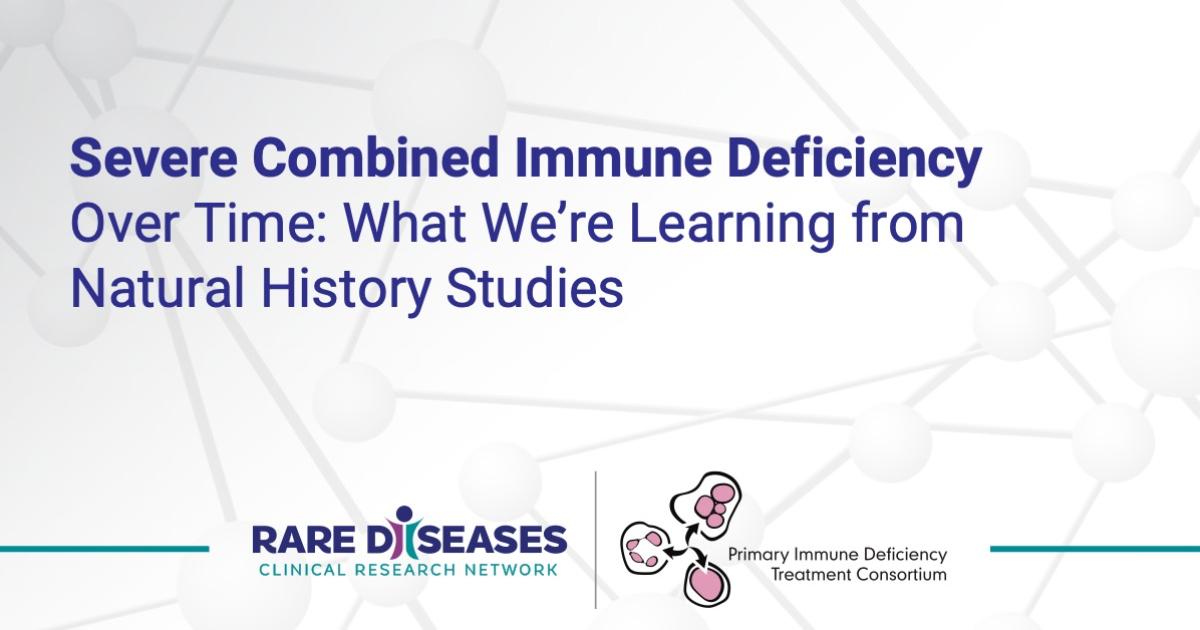Severe combined immune deficiency (SCID) is an inherited disorder characterized by extreme weakness or absence of immune system function, manifesting at birth. A dysfunctional immune system is unable to properly defend the body from bacteria, fungi, or viruses, resulting in recurrent, persistent, sometimes life-threatening infections.
To learn more about the natural history of patients with SCID, the Primary Immune Deficiency Treatment Consortium (PIDTC) is conducting two studies, “A Prospective Natural History Study of Diagnosis, Treatment and Outcomes of Children with SCID Disorders” and “Severe Combined Immune Deficiency: Prospective and Longitudinal Study of Genotypes, Management and Outcomes.” The team is learning about outcomes from the treatment of SCID in the modern era of medicine; what factors lead to the best long-term outcomes, such as best donor, conditioning regimen, and timing of transplant; and the impact of newborn screening and the early diagnosis of SCID on long-term outcomes following blood and marrow transplant (BMT) or gene therapy.
Here, lead investigator Christopher Dvorak, MD, and SCID family member Suh-Yun Wu share more about the study and what it’s like to participate.
What makes these studies unique?
Dr. Dvorak: These are the only large natural history studies for SCID in North America. Without them, centers would be left attempting to study these diseases on their own, making it challenging to have sufficient numbers to prove conclusively certain hypotheses.
How did you become involved with these studies?
Wu: My son Jason, age 12, is diagnosed with X-linked SCID. I believe we heard about these studies from the immunologist (Jennifer Puck, MD) and bone marrow transplant doctor (Morton J. Cowan, MD) and decided to participate.
What are we learning about SCID from these studies?
Dr. Dvorak: We have learned many things from these studies over the last 15 years:
- As tools have evolved, we refined the very definitions of SCID, recognizing that thymic disorders can often mimic SCID.
- We have learned that the genotypic differences within the larger SCID bucket drive differences in treatment approaches and outcomes.
- We have learned that the primary driver of poor outcomes is pre-hematopoietic cell transplantation (HCT) active infections, developed guidelines to prevent pre-HCT infections, and demonstrated that newborn screening has resulted in a significant improvement in overall survival in the last decade.
- We have shown that use of pre-HCT conditioning can improve certain aspects of immune reconstitution and that the quality of immune reconstitution impacts overall survival.
- We have begun to identify factors associated with long-term side effects of treatment.
Why did you decide to join these studies?
Wu: More research is better. We hope our participation will help with improved practices, outcomes, and of course cures! It's my hope that studies will bring more awareness and funding to SCID.
How have these studies contributed to clinical trial readiness?
Dr. Dvorak: The Pediatric Transplantation & Cellular Therapy Consortium (PTCTC) Conditioning SCID Infants Diagnosed Early (CSIDE) trial comparing two different conditioning regiments could not have been developed and initiated without the preliminary data obtained from the SCID natural history studies.
What are the challenges of these studies?
Dr. Dvorak: SCID is a rare disease, and every patient enrollment is critical. Institutional review board (IRB) and regulatory barriers have slowed down progress of enrolling patients.
What has it been like for you and your son to participate in these studies?
Wu: Jason has provided blood samples, and I’ve filled out some questionnaires. The experience has not been difficult—we are happy to participate in any way.
How will these studies impact patients, now or in the future?
Dr. Dvorak: These studies have already transformed the approach to diagnosis and HCT for SCID patients. We are continuing to study some unanswered questions, such as attempting to identify the “missing” genotypes of some patients, how best to prevent pre-HCT cytomegalovirus (CMV) infection, how best to condition patients for HCT to optimize immune reconstitution while minimizing late effects, and the precise burden of late effects following different treatment approaches.
How could these studies impact your lives?
Wu: We know that other SCID kids have gone through diagnosis and treatment before Jason. There is no doubt that all the collective knowledge and information have been helpful in his journey with SCID, which continues to be the case today. We are awaiting gene therapy for him in the near future (hopefully). We hope it will be life-changing.
“A Prospective Natural History Study of Diagnosis, Treatment and Outcomes of Children with SCID Disorders” and “Severe Combined Immune Deficiency: Prospective and Longitudinal Study of Genotypes, Management and Outcomes” are currently enrolling. Visit each study page to learn more and how to join.
The Primary Immune Deficiency Treatment Consortium (PIDTC) is part of the Rare Diseases Clinical Research Network (RDCRN), which is funded by the National Institutes of Health (NIH) and led by the National Center for Advancing Translational Sciences (NCATS) through its Division of Rare Diseases Research Innovation (DRDRI). PIDTC is funded under grant number U54AI082973 as a collaboration between NCATS and the National Institute of Allergy and Infectious Diseases (NIAID).






